New Town Project in Seoul
Introduction
The new town project was designed to maintain the equality of basic living service facilities and educational conditions across the regions and alleviate the financial gap between autonomous regions (Gu). By doing so, it set an ultimate aim at improving the urban functions comprehensively in living areas. The new town plan deals with the combination of several neighborhood districts (Gu) in the same living zone. Therefore, it targets an entire scope of several projects that influence residents' city lives.
Background
Introduction of New Town Project for Balanced Regional Development in Gangnam and Gangbuk Areas
A regional imbalance between Gangnam and Gangbuk regions started to occur due to the "policy for suppressing downtown concentration and promoting Gangnam development" since the 1970's. Its issue began to appear in the early 1990's, but has become a serious social problem since the 2000's with the sudden rise of housing prices in Gangnam. After the third popular election, the Seoul government established a four-year plan for public administration (2002-2006) in 2002 and introduced the "new town project" for regenerating the deteriorated residential area in Gangbuk region in order to actively resolve the regional unbalance.
New Renewal Method for Wide-Area Old Housing Sites in Living Space Units
The renewal of existing residential sites was conducted mainly as a private-led individual project on a small scale, so its development could be hardly linked with those of other adjacent regions. There was also a limit to installing urban infrastructures including roads, parks and school sites, thus making it difficult to improve the residential environments in living space units. Accordingly, there was a growing need for solving the problem of connecting the infrastructure with adjacent areas, which had occurred from private-led individual projects including redevelopment and reconstruction, and for laying the framework to secure the infrastructures in terms of wide-area living spaces.
Forming the Community of Various Social Groups through Resettlement of Original Residents
Since the existing redevelopment projects used to put the priority on making development profits, most low-income native inhabitants found it difficult to settle down again, thus pushing the established community into collapse. Therefore, there was a growing need for shortening a project period through joint investments in the infrastructure, alleviating the heavy burden on residents, and increasing the rate of resettlement of original residents.
<Figure 1> Comparison between Existing Urban Regeneration and New Town Projects

<Figure 1> Comparison between Existing Urban Regeneration and New Town Projects

Development Process
The Seoul government's New Town Project can be roughly divided into three periods; time for starting a pilot new town project, time for designating the new town extension, and time for converting into the renewal promotion district.
Pilot New Town (2002)
Time for the pilot new town project fell on the period when the three pilot project districts were designated in October, 2002. At that time, a balanced regional development promotion division was established according to the plan for installing the organization in charge of dealing with pending policies.
Designation of New Town Extension (2003 - 2005)
The Seoul government enacted the "ordinance on the balanced development support for Seoul," so that it could announce the 12 districts for the second new town in November of the same year after receiving applications from each autonomous district (Gu). At that time, the government reformed and extended the existing balanced regional development promotion division into the new town project headquarters in order to effectively manage the districts in second new town.
Conversion into Renewal Promotion District (2005 - 2007)
The Seoul government lacked legal grounds for both the pilot and second new town projects, and found it impossible to take various mitigation measures to promote the business more efficiently. Therefore, the Seoul government proposed a new town special act (tentatively named) to the central government in August, 2005.
With this as momentum, it enacted the special act for urban renewal promotion in December of the same year, thus laying the legal foundation for the new town project.
According to this enactment of the special law, the new town project headquarters was reformed into the regional balanced headquarters in August, 2006. Then, the government enacted the special ordinance for Seoul City's urban renewal promotion to make a decision on various matters delegated by laws.
At that time, a total of 11 districts (8 districts in December 2005 and an additional 3 districts then) were designated as the third new town project. Those of the third new town project were designated as the "urban renewal promotion district" after the enactment of the special act, so its planning process and determined contents were different from those of the pilot and second new town projects, where they used to be performed under the previous municipal ordinance.
Since the enactment of the special law, some of the pilot and second new town districts came up for discussion as a renewal promotion district, so that the new town districts could coexist with the renewal promotion districts.
<Figure 2> Promotion System Changes

Promotional Details
Changes to Seoul City's Promotional Organizations
Installation of Regional Balanced Development Promotion Division
In July, 2002, the department taking charge of the new town project in Seoul was the regional balanced development promotion division, which had been established as a separate organization. At the time of establishment, it consisted of three teams; a regional plan team, a traditional market task force and a regional development project team under the umbrella of the urban planning bureau. Then, it was put under the direct control of the vice mayor in order to carry out the new town project more actively and the housing bureau was designated as an assistant department in order to organize a more effective project promotion system.
Extension and Reform into New Town Project Headquarters
The regional balanced development promotion division was extended and reformed into the new town project headquarters in February, 2004. During that process, the balanced development promotion districts were designated along with the second new town. For its effective business, the regional plan team was reorganized into the promotional district project team. For the effective management of 12 new town districts (second), the new town master team was extended and reorganized into three teams; the general coordination team, the facilities planning team and the plan management team.
Reorganization into Balanced Development Headquarters
The special act on urban renewal promotion was enacted in December, 2005. As this special law was put into effect in July, 2006, the new town project headquarters was reorganized into the balanced development headquarters in August of the same year. The balanced development headquarters was divided into a downtown revitalization planning division and a new town project planning division. The existing new town master team was disassembled and transformed into a new project system where there were one to seven project teams under the control of three officers within the new town project planner.
<Figure 3> Promotional System for Regional Balanced Development Promotion Division

<Figure 4> Promotional System for New Town Project Headquarters
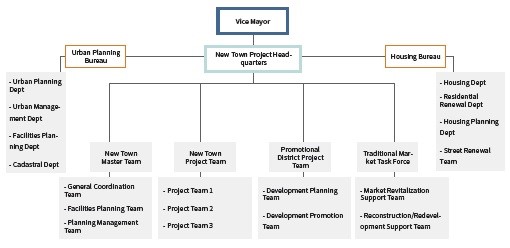
<Figure 5> Promotional System for Balanced Development Headquarters

<Figure 3> Promotional System for Regional Balanced Development Promotion Division

<Figure 4> Promotional System for New Town Project Headquarters

<Figure 5> Promotional System for Balanced Development Headquarters

Other Organizations
Regional Balanced Development Committee / Urban Renewal Committee
The regional balanced development committee was established in April, 2003 according to the ordinance, in order to deliberate on and consult on matters regarding the policies and projects for balanced development in Seoul City. It gives advice on various matters such as establishing basic plans, designating project districts, establishing renewal plans (designating districts) for each project execution type, making detailed plans for project execution before authorization and determining the target and scope of supporting project costs.
The urban renewal committee was organized in December, 2006 along with the execution of the special law. Along with the roles of the former regional balanced development committee, this committee deals with matters regarding the renewal promotion districts and their promotional plans.
The urban renewal committee was organized in December, 2006 along with the execution of the special law. Along with the roles of the former regional balanced development committee, this committee deals with matters regarding the renewal promotion districts and their promotional plans.
Task Force by Autonomous Districts (Gu)
Within the autonomous districts (Gu), the organizations in charge of projects, including a balanced development promotion division, a balanced development promotion group, a balanced development project division, a new town project group and a new town project team, were set up to play various roles; supporting Seoul City's planning, giving assistance with data for new town plans, discussing the projects with residents and collecting their opinions, and establishing basic development plans.
Master Planner (MP)
The Master Architect (MA)/Master Planner (MP) method involves authorizing one architect to maintain the systematic design of outdoor spaces in carrying out a large-scale project with different owners and development periods within a development area, and entrust him/her with the role of coordinating different designs, thus drawing an overall plan for development of the entire land. The MA/MP method in the new town project will play a role of a coordinator and controller that integrates and coordinates various opinions and interests together.
- Consisting of experts in various fields such as urban planning, urban design, construction, landscaping, transportation and business feasibility
- Consisting of general MA/MP, advisory MA/MP, public officials, etc.
- Determining various plan-related alternatives and decisions in the MA/MP conference
- Participating in the whole process of establishing a basic direction for plans, a development direction and a basic development plan
- Playing a role in integrating and coordinating a number of project districts
Designator and Agent: SH Corporation
SH Corporation was designated as a business operator for new town project by the Seoul government and has carried out the establishment and execution of a new town plan. It was designated in that its organizational characteristics are suitable to promptly deal with the whole process of the project including compensation, planning, design, construction and sale. With regard to the new town project, the organizational system of SH Corporation has a new town project office under the urban restoration headquarters, and also has sub six teams including a planning design team, a civil engineering team, construction teams 1 and 2, a mechanical team and an electrical communication team. It takes charge of various jobs; designating new town districts, designating and notifying project operators, approving and notifying new town project development/execution plans, establishing civil engineering plans, approving/permitting their execution, ordering and supervising construction, establishing basic plans, and doing basic/detailed designs.
Step-by-Step Special Organizations for New Town Development Basic Plans
There are also special organizations for each step in establishing basic plans for new town development, including a new town development promotion council, a working-level new town promotion team, and a development advisory committee.
Related Institutional Changes
Enactment of Ordinance on Regional Balanced Development Support in Seoul
The Seoul government has prepared its administrative and financial assistance plans for regional balanced development by designating the three districts of Eunpyeong, Gireum and Wangsimni as pilot districts in October, 2002 and enacting the "ordinance on regional balanced development support in Seoul" in March, 2003. The corresponding ordinance was designed to make a great contribution to urban development and provide better quality of living by setting a direction for regional balanced development policies, standardizing its execution procedure and method for efficient promotion of the regional balanced projects, and institutionalizing administrative and financial assistances.
It made an attempt to connect the pilot new town districts with its upper plans, related urban plans and other development projects and to pursue eco-friendly and sustainable development, considering the characteristics of Gangbuk region, and laid down the principle for creating a harmonious space with the coexistence of people from various income brackets and generations in order to diversify rental houses and raise the resettlement of original residents.
It made an attempt to connect the pilot new town districts with its upper plans, related urban plans and other development projects and to pursue eco-friendly and sustainable development, considering the characteristics of Gangbuk region, and laid down the principle for creating a harmonious space with the coexistence of people from various income brackets and generations in order to diversify rental houses and raise the resettlement of original residents.
Proposal of New Town Special Act and Enactment of Special Act on Urban Renewal Promotion
The pilot and second new town projects were based on the "ordinance on regional balanced development support in Seoul." Then, the Seoul government prepared a special new town act (bill) and submitted its proposal to the central government in summer, 2005 in order to solve the problem of having no legal grounds for new town projects and to promote a more efficient and comprehensive renewal project for worn-out residential areas.
With this proposal as momentum, the bill was renamed during the discussion in the National Assembly session, and the "special act on urban renewal promotion" was enacted in December, 2005 and became the legal basis for the new town project in Seoul.
With this proposal as momentum, the bill was renamed during the discussion in the National Assembly session, and the "special act on urban renewal promotion" was enacted in December, 2005 and became the legal basis for the new town project in Seoul.
Enactment of Special Ordinance on Urban Renewal Promotion in Seoul
According to the enactment and proclamation of the Special Act on Urban Renewal Promotion and the enforcement decree of the same law, a special ordinance on urban renewal promotion in Seoul was enacted to specify the delegated matters by law and others necessary for their execution. This ordinance includes the contents of the criteria for designating new town districts or balanced development promotion districts, establishing plans, project execution methods and project financing.
<Figure 6> New Town Project's Institutional Changes and Progress History
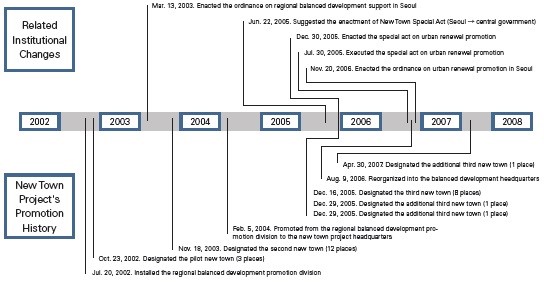
<Figure 6> New Town Project's Institutional Changes and Progress History

Financing
Urban Renewal Special Accounting
The new town budget was originally raised through urban development special accounting according to the "ordinance on regional balanced development support" for the pilot and second new town districts. Starting with the third new town district, the budget was secured through urban renewal special accounting according to the "special ordinance on urban renewal promotion" enacted in 2007.
The financial resources of the urban development special accounting consist of 11 items including the money transferred from general accounting and the government subsidy, which can be used for the new town project as well as others. So, it cannot be considered a stable resource for the new town project.
On the other hand, the tax revenues of urban renewal special accounting consist of the money transferred from general accounting, government subsidy, municipal-reverted congestion charges, urban planning tax of 30%, etc. It is meaningful as a stable resource based on the law for supporting a renewal promotion project.
The national treasury for new town project is just 1.2 billion won, making up 0.6% of the entire budget of urban renewal special accounting. So, it fails to draw much support from the central government and the most of the budget was appropriated from the Seoul government's own budget (money transferred from general accounting and congestion charges).
The new town project budget is generally supported for establishing a basic development plan and installing the infrastructure. About 80% (110 billion won) of the execution budget was supported specifically for installing the infrastructure in 2007 when renewal special accounting was first introduced.
<Table 1> Status of Tax Revenues on New Town Project (Unit: 1 million KRW)
The financial resources of the urban development special accounting consist of 11 items including the money transferred from general accounting and the government subsidy, which can be used for the new town project as well as others. So, it cannot be considered a stable resource for the new town project.
On the other hand, the tax revenues of urban renewal special accounting consist of the money transferred from general accounting, government subsidy, municipal-reverted congestion charges, urban planning tax of 30%, etc. It is meaningful as a stable resource based on the law for supporting a renewal promotion project.
The national treasury for new town project is just 1.2 billion won, making up 0.6% of the entire budget of urban renewal special accounting. So, it fails to draw much support from the central government and the most of the budget was appropriated from the Seoul government's own budget (money transferred from general accounting and congestion charges).
The new town project budget is generally supported for establishing a basic development plan and installing the infrastructure. About 80% (110 billion won) of the execution budget was supported specifically for installing the infrastructure in 2007 when renewal special accounting was first introduced.
<Table 1> Status of Tax Revenues on New Town Project (Unit: 1 million KRW)
| Classification | 1st Session | 2nd Session | |||||||
| 2003 | 2004 | 2005 | 2006 | 2007 | 2008 | 2009 | 2010 | 2011 | |
| Urban Development Special Accounting | 24,800 | 128,400 | 131,459 | 35,561 | - | - | - | - | - |
| Urban Renewal Special Accounting | - | - | - | - | 202,200 | 290,400 | 181,310 | 248,060 | 149,000 |
| Source: Written settlement of accounts concerning revenue and expenditure (2003-2011) | |||||||||
<Figure 7> New Town Project's Budget Execution Details
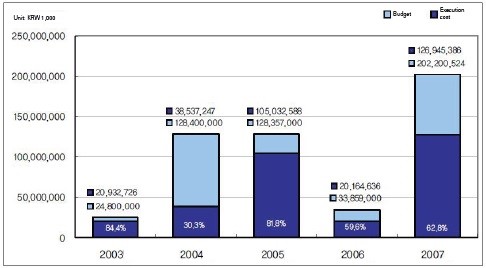
Promotional Content
The Seoul government's new town project has been put into execution on three different occasions. A total of 26 districts have been designated as new town districts and their areas make up 23.8㎢, which accounts for about 4% of the entire area of Seoul.
<Figure 8> Status of Designated New Town Districts
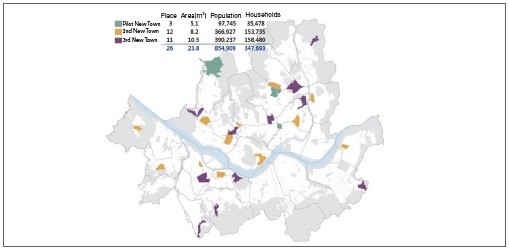
<Table 1> Status of Designated New Town Districts
<Figure 8> Status of Designated New Town Districts

<Table 1> Status of Designated New Town Districts
| Classification | District | Date of Designation |
Area (m2) |
Population (persons) |
Total Households |
Tenant Households |
Ratio of Tenants (%) |
|---|---|---|---|---|---|---|---|
| Pilot New Town 3 Districts (2002) |
Eunpyeong | Oct. 23. 2002 | |||||
| Gireum | Oct. 23, 2002 | ||||||
| Wangsimni | Oct. 23, 2002 | ||||||
| Sub-total | 2002 | ||||||
| 2nd New Town 12 Districts (2003) |
Donuimun | Nov. 18, 2003 | |||||
| Hannam | Nov. 18, 2003 | ||||||
| Jeonnong /Dapsimni |
Nov. 18, 2003 | ||||||
| Junghwa | Nov. 18, 2003 | ||||||
| Mia | Nov. 18, 2003 | ||||||
| Gajaeul | Nov. 18, 2003 | ||||||
| Ahyeon | Nov. 18, 2003 | ||||||
| Sinjeong | Nov. 18, 2003 | ||||||
| Banghwa | Nov. 18, 2003 | ||||||
| Yeongdeungpo | Nov. 18, 2003 | ||||||
| Noryangjin | Nov. 18, 2003 | ||||||
| Cheonho | Nov. 18, 2003 | ||||||
| Sub-total | 2003 | ||||||
| 3rd New Town 11 Districts (since 2005) |
Imun/ Hwigyeong |
Jan. 26, 2006 | |||||
| Jangwi | Dec. 16, 2005 | ||||||
| Sanggye | Dec. 16, 2005 | ||||||
| Susaek/ Jeungsan |
Dec. 16, 2005 | ||||||
| Bukahyen | Dec. 16, 2005 | ||||||
| Siheung | Dec. 16, 2005 | ||||||
| Singil | Dec. 16, 2005 | ||||||
| Heukseok | Dec. 16, 2005 | ||||||
| Sillim | Dec. 16, 2005 | ||||||
| Geoyeo/ Macheon |
Dec. 16, 2005 | ||||||
| Changsin/ Sungin |
Apr. 30, 2007 | ||||||
| Sub-total | 2005 - 2007 | ||||||
| Total | |||||||
Source: Seoul City's balanced development headquarters, New town project 1 officer's internal data (Sep. 2008)
Pilot New Town: Eunpyeong District (New Town Type)
Eunpyeong New Town is located at Jingwan-dong and Gupabal-dong within Eunpyeong-gu, Seoul, and its area amounts to about 3.5㎢. The district designated as Eunpyeong New Town had also been designated as a limited development district (LDD) from 1970's. Thus, construction was restricted there for almost 30 years. So, its residential environments were very worn out. Accordingly, the new town project for this district was put into execution with an aim at reorganizing and improving the obsolete residential living environments in terms of regional balanced development.
<Figure 9> Eunpyeong New Town Location

<Figure 9> Eunpyeong New Town Location

Objectives & Basic Direction
Eunpyeong New Town project was launched with the following three objectives; ① creating an ecological residential space together with its adjacent areas, ② constructing a regional exchange network and creating culture and ③ characterizing green transportation based on public transportation. Accordingly, this project was intended to improve residential environments and create a community space by setting its basic direction toward community-centered, socially
Details
The Eunpyeong New Town district was intended to build a residential area that can accommodate about 16,000 households, secure necessary infrastructure and carry out district-centered commercial functions from 2004 to 2011.
Land Use and Architectural Plan: Its plan for land use consisted of apartment-centered housing sites (39%), commercial sites (3%), infrastructure (54%) such as roads, parks, schools and parking lots and others (5%).
Transportation Plan: It was planned to build an interregional main road (San Tongil-ro, Yeonseo-ro, etc.), newly establish and adjust internal roads within the district and form a circulation network of neighborhood streets and bike lanes so that it could raise the efficiency of land use and form a center around Gupabal Station.
Park & Green Area Plan: It conceived a green system that maximizes the preservation of the existing green areas and builds three greenbelts and linear parks which make contact with watersides. It also conceived an ecological green system that connects two green belts (north and south) and also connects the separate green areas and ecosystems with each other through the installation of eco-bridges (3 places) for the connection of parks.
Plan for Infrastructure and Public Facilities: It planned educational facilities including five elementary schools, two middle schools and four high schools, and also public buildings including fire stations, post offices, patrol divisions and community service centers.
Characterization Plan: It was intended to build neighborhood streets such as a street of harmony, a street of festival and a street of family and also made a plan for forming an ecological wetland park, protecting cultural heritage and recovering small brooks.
<Figure 10> Land Use Plan
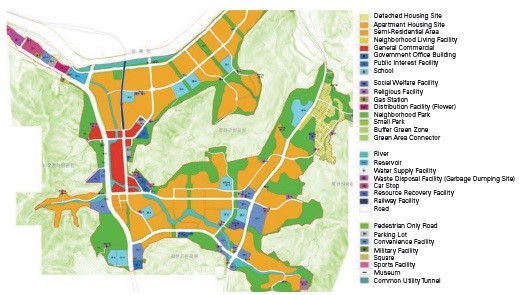
<Figure 11> Road Network Plan

Land Use and Architectural Plan: Its plan for land use consisted of apartment-centered housing sites (39%), commercial sites (3%), infrastructure (54%) such as roads, parks, schools and parking lots and others (5%).
Transportation Plan: It was planned to build an interregional main road (San Tongil-ro, Yeonseo-ro, etc.), newly establish and adjust internal roads within the district and form a circulation network of neighborhood streets and bike lanes so that it could raise the efficiency of land use and form a center around Gupabal Station.
Park & Green Area Plan: It conceived a green system that maximizes the preservation of the existing green areas and builds three greenbelts and linear parks which make contact with watersides. It also conceived an ecological green system that connects two green belts (north and south) and also connects the separate green areas and ecosystems with each other through the installation of eco-bridges (3 places) for the connection of parks.
Plan for Infrastructure and Public Facilities: It planned educational facilities including five elementary schools, two middle schools and four high schools, and also public buildings including fire stations, post offices, patrol divisions and community service centers.
Characterization Plan: It was intended to build neighborhood streets such as a street of harmony, a street of festival and a street of family and also made a plan for forming an ecological wetland park, protecting cultural heritage and recovering small brooks.
<Figure 10> Land Use Plan

<Figure 11> Road Network Plan

| <Figure 12> Bird's Eye View | <Figure 13> Park/Green Area Plan |
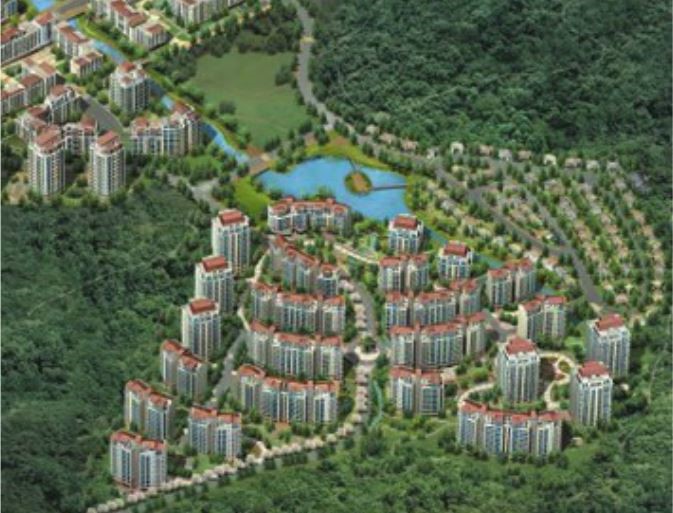 |
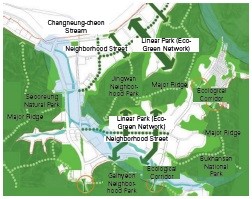 |
Promotional Process
Eunpyeong New Town was selected as a candidate for the pilot new town project on October 23, 2002. Its basic development plan was announced in April 2003 and it was designated as an urban development zone on December 30, 2003 through a public inspection, a public hearing and the deliberation of Seoul's urban planning committee. Starting from the notice of implementation plan approval for the 1st district of Eunpyeong New Town in December 2004, the approval of implementation plan for the second and third districts was notified in December, 2006. The first district's construction was completed in June 2008, the second one was constructed in December 2008, and the third one was done in June 2010.
Second New Town: Ahyeon District
Ahyeon New Town, located within 3km of downtown Seoul, is equipped with good educational conditions as well as easy access to public transportation, because it is adjacent to a number of universities including Yonsei University and Ewha Womans University. It has an area of about1㎢ with high-density single apartments scattered around due to the past individual redevelopment and reconstruction projects, and a number of old and poor houses were distributed over a wide area. In general, there were residential buildings like detached and multiplex houses, and commercial and business buildings were placed along the main roads and subway influential areas.
<Figure 14> Ahyeon New Town's Locational Characteristics
.jpg)
<Figure 14> Ahyeon New Town's Locational Characteristics
.jpg)
Objectives and Basic Direction
Ahyeon district, designated as the second new town, was set up under the theme of "complex life culture town" that represents the urban future with the coexistence of human beings, nature and culture. Accordingly, it aimed to realize a human-friendly, nature-friendly and culture-friendly new town and established more detailed objectives as follows.
| Objectives | Detailed Content |
|---|---|
| Human-Friendly New Town | Establish a construction plan to allow original and new residents to coexist together Form a socially integrated space between classes, generations, and lease and sale Create pedestrian-centered neighborhood streets to enable various activities and exchanges |
| Nature-Friendly New Town | Build a circuit street system that adapts itself to geographical features of hills and integrates the earth as a whole Establish a plan for block layout, parks and green areas considering original geography Construct a green network that organically connects pedestrian spaces with rest spaces |
| Culture-Friendly New Town | Develop various cultural contents that reflect local history and culture Set a plan for multiplex cultural facilities, considering the living space system Promote multiplex space that grafts public service, education and cultural programs |
Details
Land Use and Architectural Plan: Its plan for land use included apartment-centered residential sites (62%), commercial sites (8%) and infrastructure (30%) including roads, parks, schools and parking lots. Residential buildings had 8 to 25 stories around the various housing landscapes that suit land characteristics such as a block-type, tower-type, terrace-type, court-type and flat-type. It was intended to form a socially/hierarchically integrated space by making an integrated lease/sale plan for each complex and building a community ring along the neighborhood streets.
Transportation Plan: It planned a road width in connection with business and commercial areas in order to minimize traffic load on nearby streets and appropriately distribute traffic volume in the area. Also, it took measures to minimize the use of passenger cars by forming a public transportation-centered axis as well as a safe, convenient pedestrian axis.
Park & Green Area Plan: One neighborhood park was allocated as a core and symbolic space within the district. A children's park and a cultural park were also built as organic experience places with their own specialized play and cultural themes. Also, the five small parks were built for the purpose of providing shelter to residents.
Plan for Infrastructure and Public Facilities: Community service centers, police substations, post offices, etc. were moved into complex government buildings. A daycare center and a library were created as a part of a multiplex space. Additionally, it made a plan for cultural facilities, schools, etc.
| <Figure 15> Infrastructure Layout | <Figure 16> Park & Green Area Plan |
.jpg) |
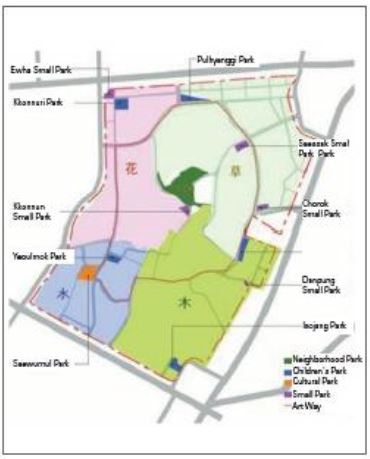 |
Promotional Process
Ahyeon New Town was designated as the second new town district in November, 2003. Then, starting from the announcement of its basic development proposal in May 2004, the basic development plan was approved in December 2004 through a presentation for residents, a consultation with related departments and a deliberation of the regional balanced development committee. Out of eight districts within the district, one was launched in November 2008 and is still underway.
Third New Town: Jangwi District
Jangwi New Town district has easy access to public transportation with three nearby subway stations and one national railroad. Its adjacent areas are also under reconstruction, including Gireum New Town, Mia New Town and Imun/Hwigyeong New Town. It has an abundant natural environment including a river and neighborhood parks.
<Figure 17> Jangwi New Town Location
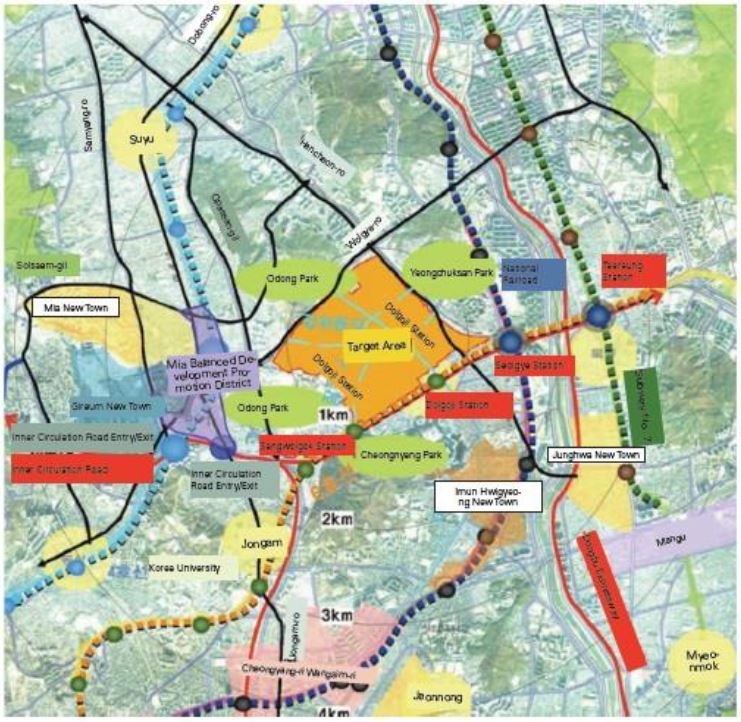
<Figure 17> Jangwi New Town Location

Objectives and Basic Direction
Jangwi New Town district has set detailed goals as follows, under the ultimate goals to build an eco-friendly city, cultural city, well-organized city and young and lively city.
| Goals | Details |
| Eco-Friendly City | Build the Green+Blue network that connects new town inside and outside Supply a residential site designed to recover natural environments, conserve good resources and adapt to geographical features Maximize the utilization of existing resources Expand living zone-centered parks and green areas |
| Cultural City | Form a central street of living zone as a central space for cultural fun Build a platform for delivering culture and art Create a daily cultural experience space, centering on community service centers Characterize neighborhood streets |
| Well-Organized City | Secure public facilities and cultural/welfare facilities for each living zone Construct a public/green-centered transportation system Improve the transportation system with better road width and linearity Maximize the utilization of existing urban infrastructure |
| Young and Live City | Create a young atmosphere by attracting cultural activities around nearby universities Form a community festival street and revitalize the culture/art street Build parks and community facilities within 10 minutes' distance from residential areas Construct block-type stores where main buildings harmonize with streets |
Details
Land Use and Architectural Plan: Its land use plan included apartment-centered housing sites (63%), public sites (33%) and other sites (4%). In particular, a high ratio of parks and green areas was secured (1.5%→15%) in order to build an eco-friendly new town. Apartments were planned with a minimum of 14 stories and a maximum of 33 stores according to locational characteristics (whether the area has hills or not) considering a sky line of 16 stories on average.Transportation Plan: It was intended to maximize a walking network within complexes by planning pedestrian roads that minimize the discontinuity of walks between facilities such as housing complexes, schools, parks and pedestrian's green ways, and planning a public transportation system including an efficient interval between stops considering walking rights of pedestrians.
Park & Green Area Plan: It tried to secure a maximum number parks and green areas by planning 12 parks within living zones and 7 green area connectors.
Infrastructure and Public Facilities Plan: Jangwi New Town was intended for the "1 plus 4" structure based on "central living zone + neighborhood living zone" and also made a plan for public facilities in the units of living zones, considering a plan for living zones and the boundaries of administrative districts. Accordingly, it set a plan for allocating cultural facilities in the living zones as well as public facilities such as welfare, administration and education in the neighborhood living zones.
| <Figure 18> Land Use Plan | <Figure 19> Bird's Eye View |
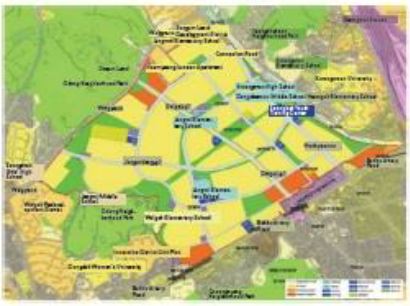 |
.JPG) |
| <Figure 20> Public Facilities Plan | <Figure 21> Transportation and Pedestrian Circulation Plan |
 |
 |
Promotional Process
Jangwi New Town was designated as the third new town district on December 16, 2005. Starting from the designation as a renewal promotion district and the determination of the renewal promotion plan in October, 2006, an application for Jangwi renewal promotion plan was made in November 2007 through the Seoul's urban renewal committee's consultation, public inspection, the district council's listening to opinions and public hearing, and its decision was made in April, 2008, so that 15 districts could be put under individual projects. Out of them, Jangwi Districts 12 and 13 were cancelled according to the sunset law and the application for union approval.
Results and Suggestions
To lay the groundwork for wide-area infrastructure by introducing the concept of renewal in the units of living zone.
The past redevelopment and reconstruction projects used to be implemented in the units of individual projects, so they could hardly be connected with adjacent projects and had a limitation of securing the infrastructure. Therefore, it was difficult to improve the residential environments in terms of living zones. However, in the new town project, the concept of renewal in the units of living zone was newly introduced to address problems with the renewal practices in the units of individual projects. Accordingly, it is meaningful that it has laid the framework for securing wide-area infrastructure within the established sections of city.
Enables various plans considering regional characteristics in the wide-area planning unit
The existing renewal for residential sites had some problems in that it took on a uniform-style renewal for apartment-centered housing sites and was also unable to carry out a planned renewal, considering regional characteristics. The new town project was performed in the wide-area unit, so it could lay the groundwork for establishing comprehensive renewal plans for various house types, sizes and densities within the district, which was impossible to do in the existing individual renewal plans.
To establish a plan with experts like the Master Planner (MP) and project manager (PM)
The existing renewal projects were performed on a private-led basis, so they tended to ignore public interests, for example, failing to secure the infrastructure by putting more focus on business feasibility and ignoring public interests such as appropriate developable density. Therefore, in the new town project, a planned system was introduced in order to help the MP, project manager and public parties participate in the planning and execution stages.
However, the new town project started in 2002, and designated 26 districts (23.8㎢) within just three years until the third new town district in 2005. Therefore, its districts were designated at a very fast speed across a wide area, causing many problems due to the lack of preparation and the insufficiency of legal systems. Furthermore, most of the designated districts were inhabited by almost 70% of tenants on average. However, the ratio of rental houses to be established (17% of total households) was low, so it was pointed out that there were not sufficient measures to help original residents resettle.
In retrospect, the Seoul government announced its measures for the new town in January 2012 and searched for a way out of the new town and redevelopment projects according to residents' opinions, and have searched for various ways by introducing new regeneration methods such as Human New Town or residential environment management project.
The past redevelopment and reconstruction projects used to be implemented in the units of individual projects, so they could hardly be connected with adjacent projects and had a limitation of securing the infrastructure. Therefore, it was difficult to improve the residential environments in terms of living zones. However, in the new town project, the concept of renewal in the units of living zone was newly introduced to address problems with the renewal practices in the units of individual projects. Accordingly, it is meaningful that it has laid the framework for securing wide-area infrastructure within the established sections of city.
Enables various plans considering regional characteristics in the wide-area planning unit
The existing renewal for residential sites had some problems in that it took on a uniform-style renewal for apartment-centered housing sites and was also unable to carry out a planned renewal, considering regional characteristics. The new town project was performed in the wide-area unit, so it could lay the groundwork for establishing comprehensive renewal plans for various house types, sizes and densities within the district, which was impossible to do in the existing individual renewal plans.
To establish a plan with experts like the Master Planner (MP) and project manager (PM)
The existing renewal projects were performed on a private-led basis, so they tended to ignore public interests, for example, failing to secure the infrastructure by putting more focus on business feasibility and ignoring public interests such as appropriate developable density. Therefore, in the new town project, a planned system was introduced in order to help the MP, project manager and public parties participate in the planning and execution stages.
However, the new town project started in 2002, and designated 26 districts (23.8㎢) within just three years until the third new town district in 2005. Therefore, its districts were designated at a very fast speed across a wide area, causing many problems due to the lack of preparation and the insufficiency of legal systems. Furthermore, most of the designated districts were inhabited by almost 70% of tenants on average. However, the ratio of rental houses to be established (17% of total households) was low, so it was pointed out that there were not sufficient measures to help original residents resettle.
In retrospect, the Seoul government announced its measures for the new town in January 2012 and searched for a way out of the new town and redevelopment projects according to residents' opinions, and have searched for various ways by introducing new regeneration methods such as Human New Town or residential environment management project.
References
Jang Nam-jong and Yang Jae-seop, 2008, "Seoul's New Town Project Implementation and Tasks for Improvement," Seoul Institute
Seoul Metropolitan City, 2012, "Seoul's Efforts and Tasks for New Town and Redevelopment Project"
Seoul Metropolitan City, 2010, "Seoul's Seven Year-Records of New Town Project"
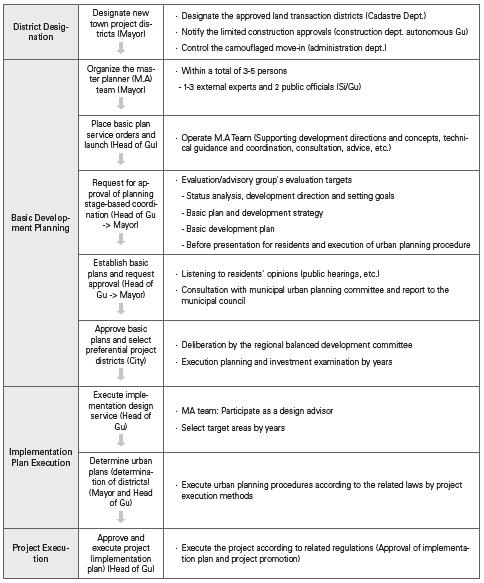
Seoul Metropolitan City, 2012, "Seoul's Efforts and Tasks for New Town and Redevelopment Project"
Seoul Metropolitan City, 2010, "Seoul's Seven Year-Records of New Town Project"
| New Town Project Procedure |
| The new town project procedure is classified into a planning stage and an execution stage. In the planning stage, a basic development plan is determined in the process of designating districts. On the other hand, in the execution stage, an implementation plan is determined, including the process of changing urban plans and designating districts for each project district, and its project is executed accordingly. Designation of New Town Project Districts
Establishing Basic Development Plans
Implementation Plan and Project Execution
|
